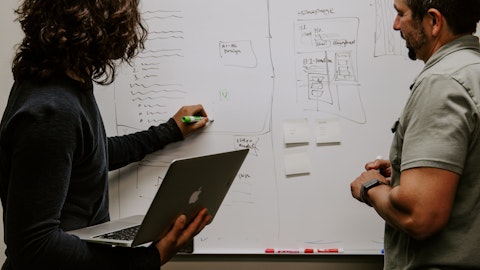But we’re looking at accuracy and quality and what consumers choose. So, I think as this tax season plays out and we get into Q3 and Q4, we will know a lot more and be able to share a lot more about our learning. The idea about pricing it for free is just the ability to strengthen the value proposition we have versus competitors. It’s really that simple. The technology is new in the world. We feel great about our core user experience in the SKU lineup and our pricing for value perception versus competition. And we thought this was a great opportunity to even strengthen the value we deliver for clients.
Scott Schneeberger: Great. Thanks again. That’s it for me. Good luck for the tax season. Congrats again, Tony.
Tony Bowen: Thanks, Scott. Appreciate it.
Operator: Thank you. Our next question comes from the line of Alex Paris of Barrington Research. Your question please, Alex.
Alex Paris: Yes. Thank you. I’ll add my congratulations as well, Tony, but we’ll talk later.
Tony Bowen: Thank you, Alex.
Alex Paris: Question on pricing, I think you just said that it’s low single-digit price increases on assisted. And then, you had said I think in the prepared text that you’re taking modest price increases on the DIY side as well. Orders of magnitude low-single-digits like assisted is my first question. And second, how has that changed, if any, the price discount versus TurboTax, for example?
Jeff Jones: So, this is Jeff. Alex, I’ll chime in first. I mean, yes, in consumer tax assisted in DIY, 2%, 3%, 4% kind of range and similar in both channels. Obviously, in DIY, we can be more dynamic with the pricing given the nature of the channel and what we see happening competitively in the market. For years now, we have maintained a price advantage relative to TurboTax. And as the quality of our experience has grown, we feel more and more confident about closing that price gap. They continue to take price dramatically. And so we’re not trying to follow their lead necessarily as they continue to take significant price increases. But we do see the ability to close the gap. We want to be really intentional about that and make sure that the consumer is telling us that they’re getting great value, things like AI Tax Assist, and the experience that they’re getting is worth paying for.
And so that’s a little bit of the thinking about how we view pricing strategy. But in DIY, it obviously is a bit dynamic than what we do in Assisted.
Alex Paris: Great. So, just a point of clarification, you said your price is up 2%, 3%, 4% on both sides, both channels, DIY, but they continue to take price dramatically. So, I would take away from that your price discount versus Turbo did not narrow, but you see the opportunity for it to narrow over time. Is that correct?
Jeff Jones: I think that’s generally right. It gets complex fast because there are so many different SKUs. There are attaches to SKUs. All of those have different price gaps. So, I’m definitely generalizing our philosophy on pricing versus trying to do a SKU by SKU lineup in comparison. Tony, would you add anything?
Tony Bowen: Well, I think the only thing is on the paid SKUs that include AI Assist, we know we’ve got a much larger price discrepancy.
Jeff Jones: Right.
Tony Bowen: So I think to your point, it depends on which SKU and which product you’re buying.
Jeff Jones: Which time of the season?
Tony Bowen: We definitely think that having an advantage is important. We’re trying to lean into that. And we know as a number two player in the DIY category, we can use price as an additional piece of the value proposition to drive volume.
Jeff Jones: Yes.
Tony Bowen: But still drive overall revenue growth, and that’s essentially been our strategy the last few years and it will continue this year.
Jeff Jones: Yes, thanks.
Alex Paris: Okay, great. I appreciate that. And then, complexity, tax code changes, while modest, do you expect any lift in NAC due to tax code changes this year?
Tony Bowen: Well, yes, we are both about to answer at the same time. Not really. I mean, this is a year where, other than CTC, it’s not a year where we see a lot of changes happening that benefit our customers. So, that’s really the one, and obviously that’s more about timing, as we talked earlier.
Alex Paris: Great. And then, I guess last question for me. H&R Block has routinely repurchased franchise locations. I assume that’s a first-half affair, given that the tax season is awfully busy. I think you target 100 to 150 per year. Do you expect to be in that same neighborhood this year?
Tony Bowen: You’re exactly right. So, we do almost all of those in the first-half. We try to close those basically before tax season starts, which is now behind us. We’re probably closer to 150-level at this point, so the team did a nice job of reacting to franchisees, being willing to sell, which has been fantastic. I mean, we love acquiring them if they’re willing buyersm or what? Sorry, if they’re willing sellers. We’re the willing buyers. It’s been a great use of capital. We’ve got a great ROI on those investments. The integration is very seamless given they’re already operating as H&R Block locations. So, we’re always willing if the locations are right, which they typically are. And like I said, this year, it probably is going to end up being about 150 in total.




